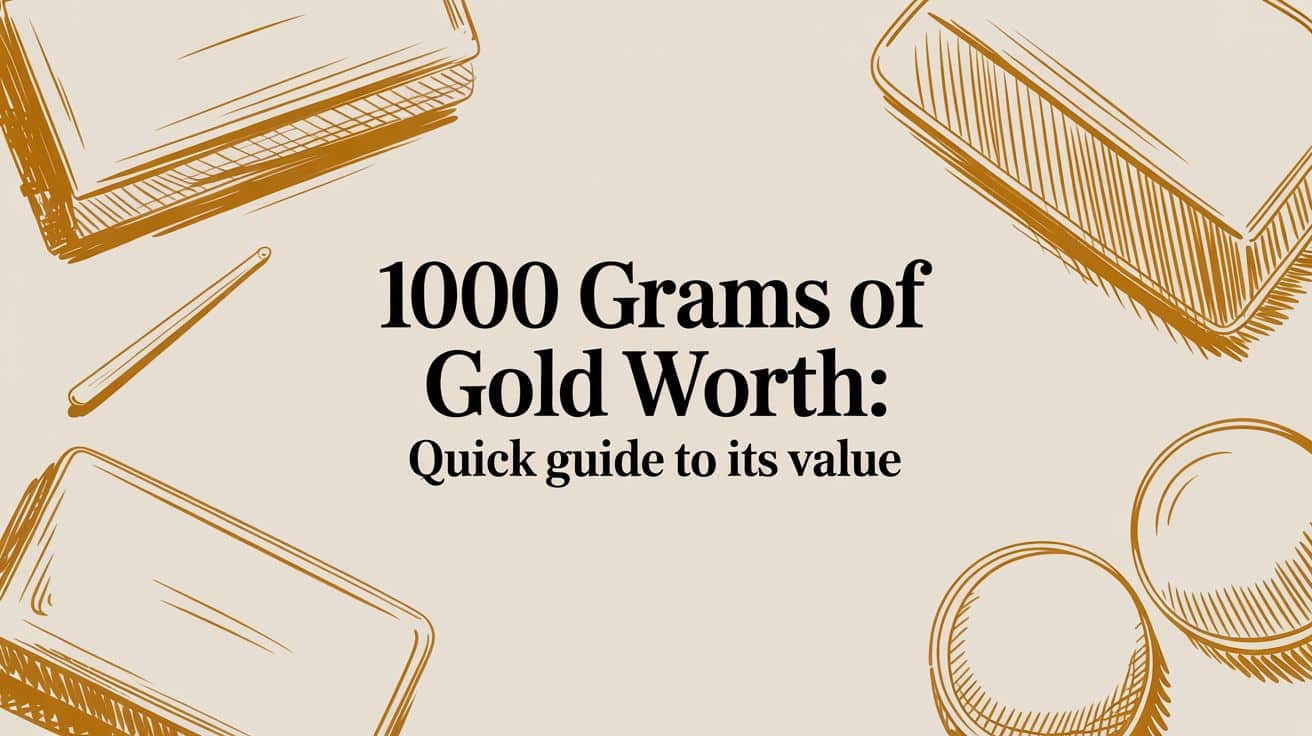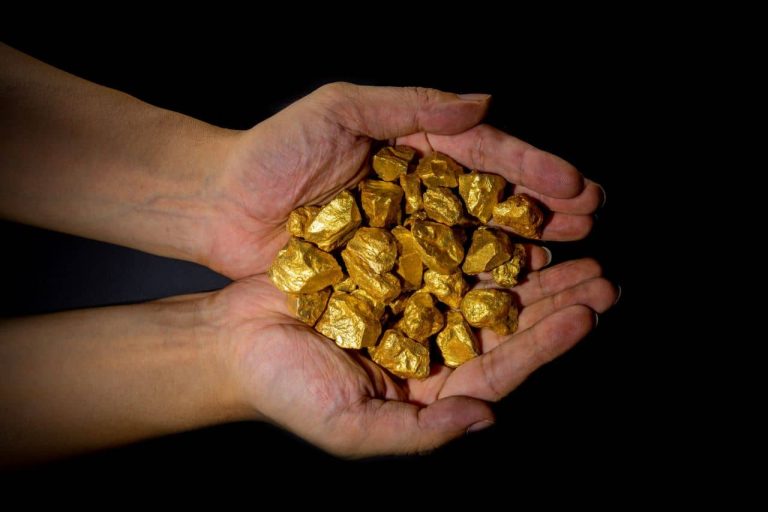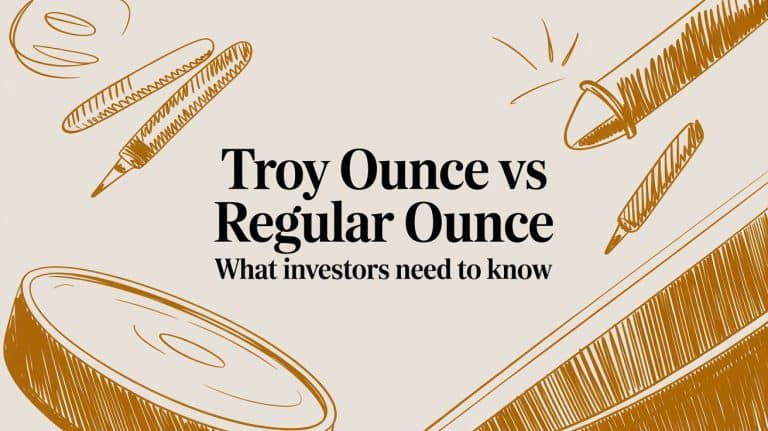How much is 1000 Grams of Gold Worth? Quick Guide to its Value
Trying to pin down the exact worth of 1000 grams of gold is a bit like trying to catch a moving target. The price is always in flux, driven by global markets that never sleep. That said, as of late 2025, a kilogram of pure 24k gold generally hovers somewhere in the ballpark of $130,000 to $135,000 USD. But you can bet that number will have changed by the time you finish reading this sentence.
Getting a Real-World Value for a Kilo of Gold (1000 Grams)
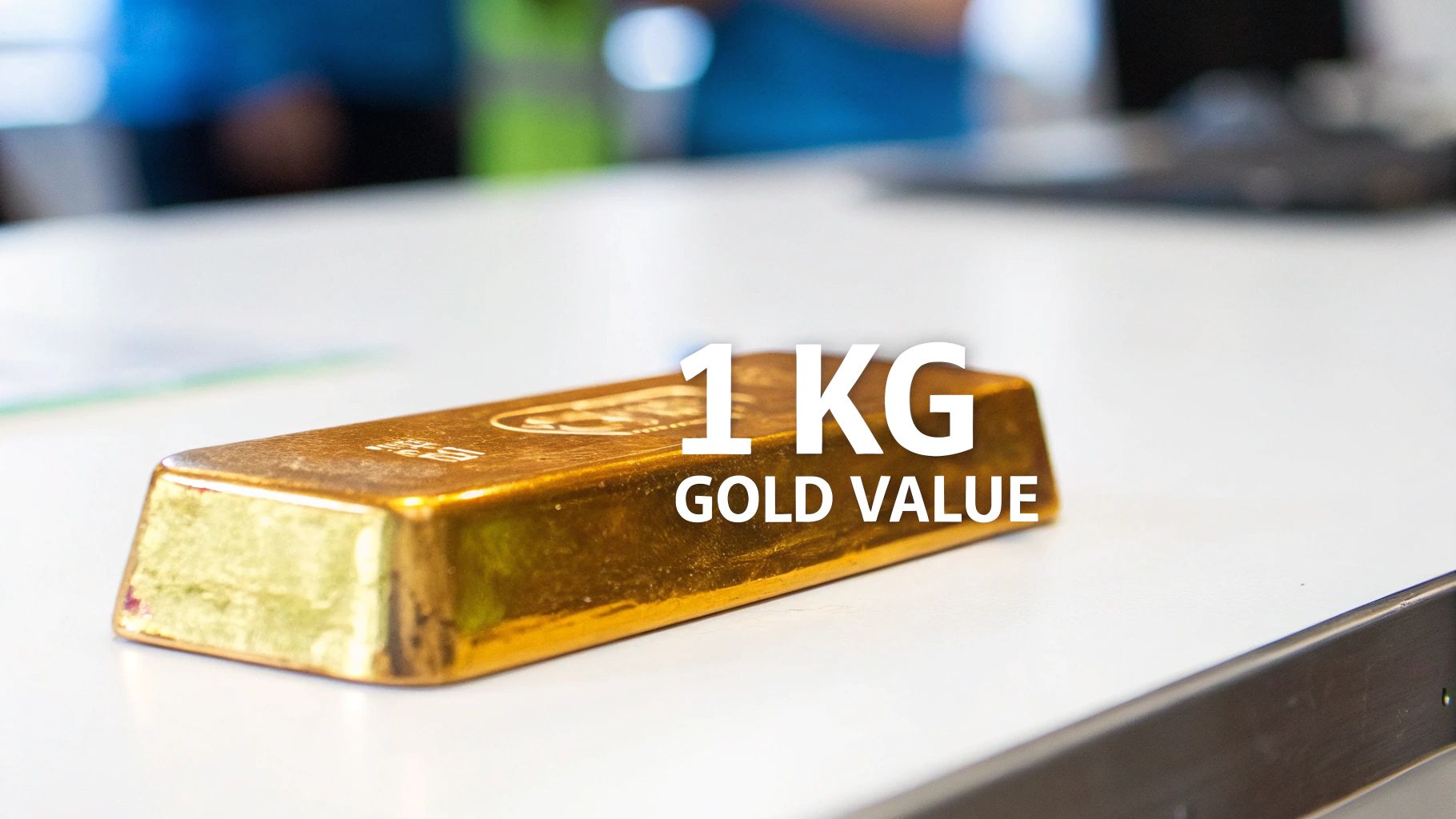
Thinking about gold in terms of a full kilogram, which is 1000 grams, is a great way to start understanding how professionals price precious metals. That big, round number seems simple enough, but it’s really just the first step on the ladder. The final cash in hand value depends on a few critical factors that all play together.
To really know what your gold is worth, you have to look past a single headline number and learn to speak the language of the gold market. Think of it like a recipe: the final dish tastes completely different depending on the quality and quantity of each ingredient you use.
The Three Pillars of Gold Valuation
When it comes to figuring out melt value, everything boils down to three core concepts: the spot price, the weight conversion, and the gold’s purity. Get these right, and you’re golden.
Live Spot Price: This is the up to the minute market price for one troy ounce of pure, 24k gold, as traded on major commodity exchanges around the world. It’s the foundation for every single gold calculation.
Weight in Troy Ounces: This is a big one. Gold isn’t measured in the same “avoirdupois” ounces you use in the kitchen. The entire precious metals world runs on troy ounces, and one kilogram is exactly 32.15 troy ounces. For a deep dive into why this matters so much, check out our guide on the gold troy ounce vs a regular ounce.
Purity (Karats): Most gold you encounter isn’t 100% pure. To make it durable enough for jewelry, it’s mixed with other metals, or alloys. We measure this purity in karats, where 24 karat (24k) is the pure stuff.
The melt value of 1000 grams of 14k gold will be significantly lower than 1000 grams of 24k gold because it contains less pure gold. This distinction is the most common reason for valuation surprises.
Once you get a handle on how these three elements work together, you can accurately figure out the base value of any gold item you have, whether it’s a tiny earring or a hefty kilogram bar. In the next sections, we will break down the math and show you exactly how to do it.
Decoding the Live Gold Spot Price

Before you can figure out what 1000 grams of gold is worth, you have to start with the live gold spot price. Think of it as the raw, wholesale sticker price for gold, set by massive global commodity markets in places like New York, London, and Shanghai. It’s the baseline number for one troy ounce of pure, 24k gold, and it’s constantly on the move, reacting to worldwide supply and demand.
This isn’t a price dreamed up by a single company. It’s a direct reflection of global sentiment, a real time story about the world’s economic health, investor confidence, and geopolitical stability.
What Makes the Spot Price Move
Gold is famously sensitive to what’s happening in the world. Its price often climbs when investors get nervous and can dip when they feel confident throwing their money into other assets.
Several key drivers are behind these daily shifts:
- Economic Uncertainty: During recessions or stock market jitters, investors often flock to gold as a “safe haven” asset. This increased demand naturally drives its price up.
- Inflation Fears: When currencies like the US dollar start to weaken from inflation, gold has a reputation for holding its value better. That makes it more appealing, and its price reflects that.
- Central Bank Activity: Don’t forget the big players. Governments and central banks are huge buyers of gold. When they decide to bulk up their reserves, they can single handedly boost demand and push prices higher.
For a real world example, look no further than recent history. As of November 2025, 1000 grams of gold is worth roughly $130,000 to $134,000 USD, a massive jump fueled by a perfect storm of these factors. This remarkable bull run has been driven by geopolitical tensions, currency uncertainty, and huge central bank accumulation, with institutions worldwide buying over 1,000 tonnes of gold annually since 2022.
The spot price is the foundation for every single gold transaction. Whether you’re buying a tiny one gram pendant or valuing a 1000 gram bar, every calculation you make starts right here with this live market rate.
Because the spot price is the benchmark for pure gold, it’s non negotiable information for anyone serious about precious metals. For a more detailed walkthrough, you can learn more about how to calculate gold price in our comprehensive guide. Getting this fundamental concept down ensures you can accurately nail down the baseline value of your assets before you even start thinking about other variables like purity and buyer fees.
Calculate the Value of Your Gold Step by Step
Ready to crunch the numbers yourself? Figuring out the base value of 1000 grams of gold is surprisingly simple once you know the formula. It’s a clean, three part process that cuts through the noise and puts you in control.
Think of it like baking a cake. You need the right ingredients in the right measurements to get a predictable result. For gold, your ingredients are the weight, the live spot price, and one crucial conversion.
Step 1: Convert Grams to Troy Ounces
First things first, we need to speak the language of the global gold market. That language is troy ounces, not the standard grams or ounces you might use in the kitchen. The conversion is a fixed number you can always rely on.
One kilogram (1000 grams) is equal to exactly 32.15 troy ounces. This is the first essential piece of our calculation.
1000 Grams = 32.15 Troy Ounces
This isn’t just a suggestion; it’s the non negotiable standard used by precious metals professionals all over the world.
Step 2: Find the Current Gold Spot Price
Next up, you need the live spot price of gold. This is the up to the minute market rate for one troy ounce of pure, 24 karat gold. You can easily find this on financial news sites, commodity trackers, or our own live price charts.
For this example, let’s use a hypothetical spot price of $4,000 per troy ounce. Just remember, this number is always in motion, so be sure to use the current price for an accurate valuation.
Step 3: Multiply to Find the Total Value
With those two numbers in hand, the final step is simple multiplication. You just multiply the weight in troy ounces by the current spot price.
Here’s the simple math:
- Weight in Troy Ounces: 32.15 oz
- Spot Price per Ounce: $4,000
- Calculation: 32.15 x $4,000 = $128,600
And there you have it. With a spot price of $4,000 per troy ounce, 1000 grams of pure gold has a raw value of $128,600. This three step process gives you the foundational melt value for your gold. While our focus is on gold, understanding general asset valuation principles can provide a broader perspective on assessing worth; you can learn more if you want to master valuation methods for other types of investments.
This calculation is perfect for pure, 24k gold. But what if your gold isn’t pure? The next section will show you how to adjust this formula for different purities, using the karat system to find the true value of any gold item you own.
How Purity and Karats Impact Final Value
Ever wondered why two gold items of the same weight can have wildly different price tags? The secret lies in one crucial factor: purity. Not all that glitters is pure gold, and understanding this concept is the key to figuring out what your 1000 grams are actually worth.
Think of pure, 24 karat (24k) gold as a powerful, concentrated syrup. It’s 100% gold, valuable and vibrant, but it’s also incredibly soft and not very practical for everyday use. To make it durable enough for jewelry, it gets mixed with stronger metals like copper, silver, or zinc. This mixture, called an alloy, is measured in karats.
So, an 18 karat (18k) piece is like a recipe that’s 75% syrup and 25% water. It still has the core ingredient, but it’s diluted. The lower the karat number, the less actual gold is in the mix.
Finding the Actual Gold Content
This distinction is everything because the spot price of gold only applies to the pure gold content within an item. To find the real value of your 1000 grams, you first have to figure out how much of that weight is pure, unadulterated gold. This means a 1000 gram bar of 14k gold isn’t 1000 grams of pure gold; it’s only 583 grams of it.
This quick infographic shows the simple flow of converting grams to ounces and then to dollars, which is the foundation of any gold valuation.
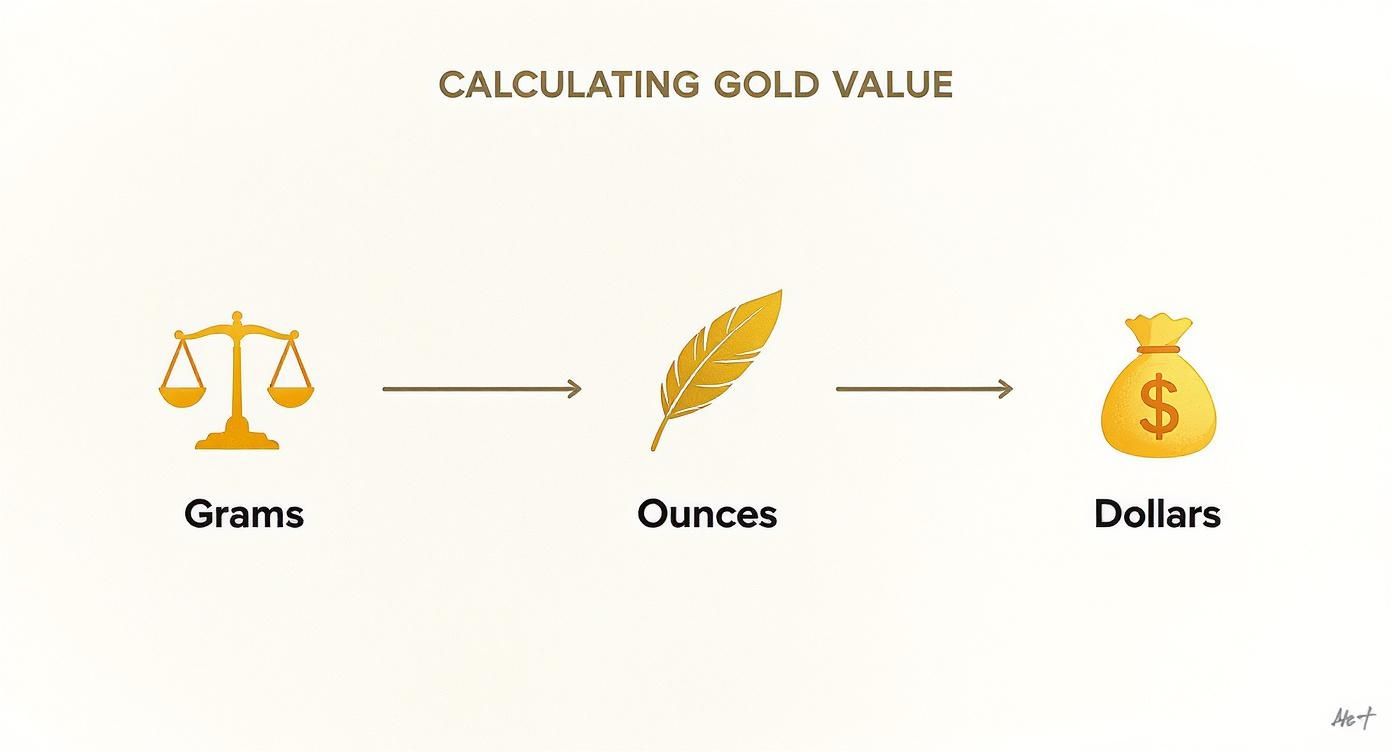
As the visual highlights, before you can even think about a dollar amount, you have to translate your item’s weight into the industry standard troy ounce.
Gold Karat Purity and Value Calculation
To make this simple, the table below breaks down the most common gold purities. It shows you exactly how much pure gold is in 1000 grams at each level and gives a real world calculation based on a sample spot price.
| Karat (K) | Purity (% Gold) | Pure Gold in 1000g | Sample Value (at $2300/oz) |
|---|---|---|---|
| 24k | 99.9% | 999 grams | $74,015.15 |
| 22k | 91.6% | 916 grams | $67,867.74 |
| 18k | 75.0% | 750 grams | $55,566.95 |
| 14k | 58.3% | 583 grams | $43,194.50 |
| 10k | 41.7% | 417 grams | $30,895.89 |
As you can see, the pure gold content, and therefore the value, drops significantly with each karat level. It’s also important to know that beyond solid gold, there are other categories like gold filled and plated items. Learning the comprehensive meaning of 14k gold-filled, gold plated, and solid gold is fundamental to assessing an item’s true worth.
Putting Purity Into Practice
Let’s walk through a calculation for 1000 grams of 14k gold, using a sample spot price of $2,300 per troy ounce.
- Step 1: Find the Pure Gold Weight. 1000 grams of 14k gold is 58.3% pure. So, 1000g x 0.583 = 583 grams of pure gold.
- Step 2: Convert to Troy Ounces. Now, we convert that pure gold weight. 583g ÷ 31.1035 = 18.74 troy ounces.
- Step 3: Calculate the Final Value. Finally, multiply by the spot price. 18.74 oz x $4,000/oz = $74,960.
The difference is staggering. While 1000 grams of pure 24k gold was worth over $128,600 in our example, the same weight in 14k gold is worth just $74,960. Adjusting for purity is easily the most important step in getting a realistic valuation.
From Market Value to Cash in Your Hand
Once you’ve calculated the market value of your gold, it’s tempting to think that’s the exact amount you’ll get when you sell. But there’s a crucial difference between that theoretical number and the cash a buyer will actually hand you. This gap isn’t a scam; it’s simply the reality of how the gold buying business works.
Think of it like selling a used car. The dealer isn’t going to pay you the full sticker price. They have rent, staff salaries, marketing, and other overhead costs to cover, plus, they need to turn a profit. Gold buyers, from local jewelers to large scale refineries, operate on the very same principle.
Why Buyers Pay a Percentage of the Spot Price
When you sell your gold, the buyer takes on real costs to process it. These expenses have to be covered by the margin they make on the transaction.
- Testing and Verification: They need specialized equipment to confirm the exact purity and weight of your gold. This isn’t just a simple scale and a magnifying glass.
- Melting and Refining: Scrap gold jewelry and other items have to be melted down and refined back into pure gold. This is an industrial process that requires a lot of energy, skilled labor, and expensive machinery.
- Business Overhead: Just like any other company, they have to pay for insurance, high level security, and employee wages.
- Profit Margin: At the end of the day, they are a business. They need to build in a profit margin to stay afloat and continue offering their services.
Because of all these factors, no buyer can pay 100% of the live spot price for scrap or secondary market gold. Instead, they’ll offer you a percentage of the total melt value.
A realistic offer for your gold will typically fall somewhere between 70% to 95% of its calculated melt value. The final percentage depends on the buyer, how much gold you’re selling, and current market demand.
A Real-World Example of an Offer
Let’s bring this into the real world. Imagine you have a one kilogram bar of pure 24k gold, and you’ve calculated its market value to be $128,600 based on today’s spot price. A reputable refinery might offer you 95% of that value.
Here’s how the math breaks down:
- Market Value: $128,600
- Buyer’s Offer (at 95%): $128,600 x 0.95 = $122,170
In this case, the buyer’s $3,500 margin is what covers all their costs and provides their profit. Understanding this “buyer’s percentage” is the key to setting realistic expectations and knowing when you’re getting a fair deal. You can check out our guide on the best place to sell gold to learn more about finding trustworthy buyers who offer competitive rates.
Given the massive value of gold, these percentages can represent a lot of money. For example, some market forecasts are predicting gold prices could climb over $4,500 per ounce in late 2025. During Q3 2025, when the average price hit a record $3,456.54 per ounce, 1000 grams of gold was worth around $110,900, helped by a 58% year over year jump in US gold demand. You can find more insights about gold’s enduring appeal on vaneck.com. This context really shows why even a few percentage points can make a huge difference in your final payout.
Still Have Questions About Gold Value?
After crunching the numbers and looking at market prices, a few common questions usually pop up. Getting these sorted out can fill in any missing pieces and help you feel a lot more confident about handling your gold. Let’s tackle some of the most frequent ones.
Why Does the Gold Industry Use Troy Ounces?
It definitely feels a little odd that gold isn’t measured in the same ounces you see at the grocery store. The entire world of precious metals runs on a special unit called the troy ounce. It’s a bit heavier than a standard “avoirdupois” ounce (31.1 grams compared to 28.35 grams), and this isn’t just for tradition’s sake, it’s a global standard that keeps everything consistent and accurate across international markets.
This system goes back centuries, creating a universal language for weighing precious metals. Whether you’re in New York, London, or Tokyo, a troy ounce is always a troy ounce. This eliminates any possible confusion from regional measurement quirks, which is absolutely critical for maintaining trust in transactions worth millions.
Does the Form of Gold Affect Its Melt Value?
People often wonder if 1000 grams of gold in a coin is worth more than 1000 grams in a necklace. When you’re talking strictly about the pure melt value, the answer is no. Gold is gold, and its raw worth comes down to its weight and purity, plain and simple.
However, the form it’s in can add value that goes beyond the melt price. This extra bit of value is called a premium.
- Numismatic Coins: Rare or collectible coins often carry a big premium based on their history, how many are left, and their condition. Their value is more about the story than the metal.
- Designer Jewelry: A piece from a famous brand like Cartier or Tiffany & Co. has value tied to its incredible craftsmanship and brand name. You’re buying the art, not just the gold.
- Gold Bullion: Even standard bars and coins from well known mints usually have a small premium because their purity is guaranteed and they’re easy to trade.
So, while the gold itself has a base value, the specific item it’s shaped into can make it worth much more to the right buyer.
What About Taxes When Selling Gold?
Yep, any profit you make from selling gold is generally considered taxable income. In the United States, for instance, gold is classified as a “collectible,” which means it’s subject to capital gains tax. The exact rate you’ll pay depends on how long you’ve owned the gold and what your income level is.
It’s a smart move to keep detailed records of what you paid for your gold and when you bought it. When you sell, you can subtract that original cost from the sale price to figure out your net profit, that’s the amount that gets taxed. Chatting with a tax professional is always the best way to make sure you’re following all the rules.
Where Can I Find Reliable Gold Prices?
With so much info swirling around online, finding a trustworthy source for the live gold spot price is essential. You need data that is accurate and constantly updated. Here are some of the most dependable places to keep an eye on the price.
This table breaks down the best sources and why you can trust them for real time gold price information.
| Source Type | Examples | Why They Are Reliable |
|---|---|---|
| Financial News Networks | Bloomberg, Reuters | They provide institutional grade data and expert analysis from the heart of the financial world. |
| Commodity Exchanges | COMEX (CME Group), LBMA | These are the actual markets where global gold prices are determined. |
| Reputable Dealers/Calculators | Reputable online bullion dealers | They pull data directly from live market feeds to power their own pricing, so their info is current. |
The bottom line is this: stick to sources that get their data straight from live financial markets. Steer clear of small, unknown websites. Their data might be delayed or just plain wrong, which could cause you to seriously miscalculate what your gold is worth.
By getting a handle on these common questions, you can navigate the world of gold valuation with a lot more clarity. From understanding why troy ounces matter to setting realistic expectations about taxes and premiums, this knowledge empowers you to make much smarter decisions.
Ready to find out exactly what your gold is worth right now? Use the free, real-time gold price calculator. Our tool uses live market data, updated every five minutes, to give you an accurate and transparent estimate of your gold’s melt value. No hidden fees, no guesswork, just a clear, instant valuation.


